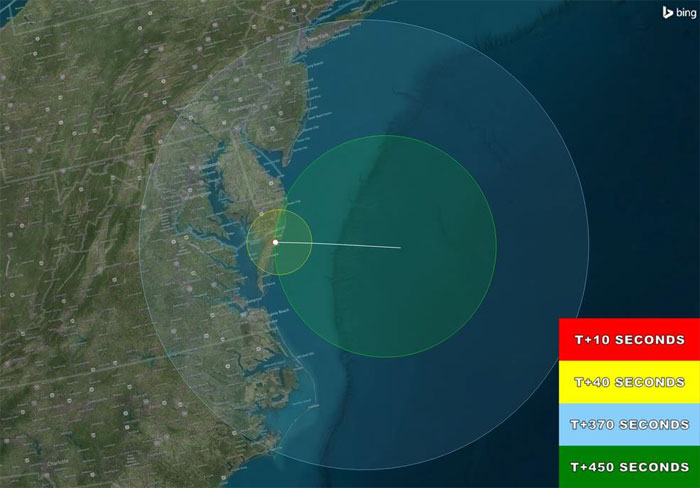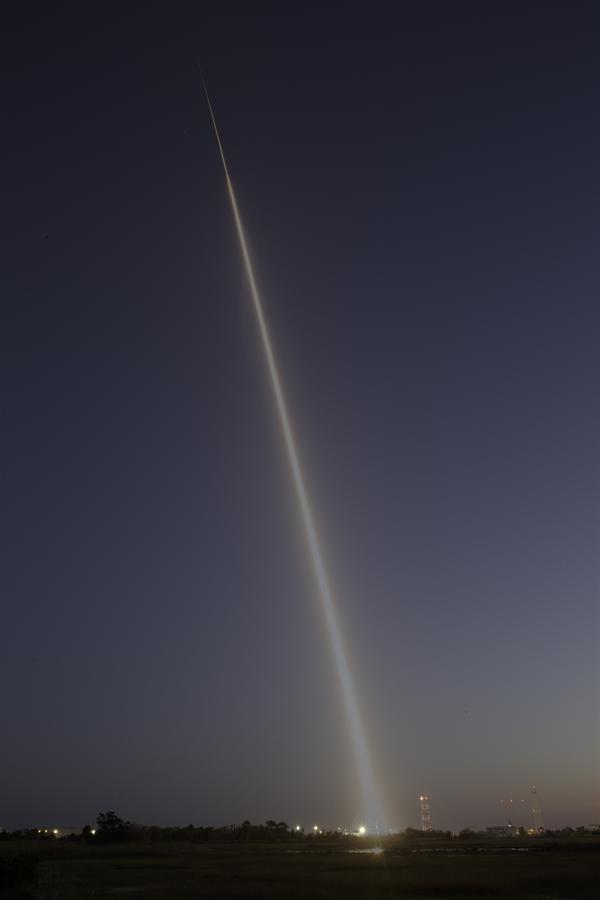.
7.10.2015

Predicted visibility map for the space technology rocket launch scheduled Oct. 7.
Credits: NASA/Mission Planning Lab
-
Rocket launches are spectacular, “wow” events that most of us don’t get to see with our own eyes. But between 7 and 9 p.m. EDT on Wednesday, Oct. 7, residents in the mid-Atlantic region of the United States may get a glimpse of NASA”s next suborbital launch from the agency’s Wallops Flight Facility in Virginia.
Approximately six minutes after launch, the sounding rocket will deploy four sub-payloads containing mixtures of barium and strontium will be released, creating a cloud that is blue-green and red in color.
Residents from Long Island, New York, 235 miles north of the launch site, to Morehead City, North Carolina, 232 miles south, 165 miles west in Charlottesville, Virginia -- and everyone in between -- could get a glimpse of the colorful evening launch.
Sounding rockets, also called suborbital rockets, are valuable tools in qualifying technologies for flight. During this suborbital flight, NASA will test a modified Black Brant sounding rocket motor, launch vehicle and spacecraft systems and sub-payload ejection technologies.
---
Before new technologies are used in spacecraft they need to be thoroughly tested. Although ground tests are often acceptable, some technologies need a “test drive” before being integrated into space vehicles.
Suborbital rockets, also called sounding rockets, are valuable tools in qualifying technologies for flight and providing the test drive that is needed.
NASA will flight test a modified Black Brant sounding rocket motor, launch vehicle and spacecraft systems and sub-payload ejection technologies during a suborbital mission between 7 and 9 p.m. EDT, Oct. 6, from the Wallops Flight Facility in Virginia.
The launch and vapor cloud releases, as part of the sub-payload ejection tests, may be seen by residents in the mid-Atlantic region. The launch window runs October 6 through 12.
The flight’s primary objective is to characterize the reformulated Black Brant motor performance in a two-stage configuration.
“The flight also provides an opportunity to test new technologies being developed for space missions and science conducted using sounding rockets,” said Cathy Hesh, technology manager in the Sounding Rocket Program Office at Wallops.
During the flight of the two-stage Black Brant IX sounding rocket, NASA will test a section of the payload fabricated using near net shape (NNS) technology from the agency’s Langley Research Center in Hampton, Virginia, and three different materials through a Cubesat experiment developed by Orbital ATK of Magna, Utah.
The machined and welded construction process for most sections of conventional rockets is expensive, adds weight and has a high degree of risk. The NNS technology provided by the Game Changing Development (GCD) program within NASA’s Space Technology Mission Directorate’s (STMD) will test a new fabrication method on the most forward section of the rocket.
Using the NNS integrally stiffened cylinder (ISC) process, a barrel section was fabricated in a single step that formed the cylinder and its stiffeners. The 17-inch diameter, 20-inch tall, near net shape cylinder will be substituted for a conventional unstiffened cylinder machined from thick-walled aluminum.
Instrumented with gauges to measure the strain on the skin in flight, the data will be compared to a conventionally machined cylinder. The aluminum section using the ISC process could offer a relatively low-cost, light-weight approach for creating near net-shape components in the future.
Orbital ATK’s GCD experiment, dubbed LEO-1, tests three different carbon nanotube (CNT) composite materials and 3-D printed primary structures. The three products being tested are an integrated 1553 data bus (CNT twisted pair and shielding with an integrated connector), CNT-coated heat and radiation shields and an ultra-lightweight CNT-composite launch vehicle/spacecraft adapter.
These technologies will bring significant value to a wide range of aerospace and defense products—including launch vehicles, spacecraft, aircraft and marine vehicles—from the estimated 40-60 percent mass savings, increased technical performance and reduced maintenance over traditional materials.
Eight students from the NASA Internships, Fellowships, and Scholarships program working at Langley were instrumental in supporting the upcoming NNS and LEO-1 experiments. Interns from Virginia Tech, Blacksburg; the University of Virginia, Charlottesville; Princeton University, Princeton, New Jersey; North Carolina State University; Raleigh; University of Washington, Seattle; University of Alabama, Huntsville; and Thomas Nelson Community College, Hampton, Virginia; performed the structural analysis of the flight cylinder, evaluated the microstructure and properties and did a cost-benefit analysis of the ISC process. They did much of the 3-D printing for the Orbital ATK tests and acted as the interface between Orbital ATK and Wallops.
The ejection technologies will include a deployment system for forming vapor clouds in space for wind and ionosphere studies and ejectable sub-payloads testing data transmissions between sub and main-payloads during suborbital rocket flights, primarily during auroral studies.
Hesh said, “These two technologies will allow researchers to make real-time onsite measurements over a much wider area and increase the amount of data obtained than is currently possible during a suborbital rocket flight.”
During the test of the deployment system for the vapor clouds, four sub-payloads with mixtures of barium and strontium will be ejected from the main payload and the vapor will be deployed while the payload is descending. The test also will include the release of vapor from two systems on the main payload during the descent portion of the flight.
The vapor tracer sub-payload deployment method being tested on this flight uses small rocket motors to eject the sub-payloads from the main payload. The ejected sub-payloads will release the vapor at about 130 miles above the Earth. The main payload releases will occur at an altitude around 118 miles.
The barium-strontium mixture produces a cloud with a mixture of blue-green and red color. The blue-green part is neutral, i.e. not charged. Strontium is used to enhance the visibility of the neutral flow.
The amount of barium and strontium used in the test is much smaller than that used in a typical July 4 fireworks display and poses no hazard to the community.
The NASA Visitor Center at Wallops will be open at 6 p.m. for viewing the launch.
Live coverage of the launch is available via UStream beginning at 6 p.m. on launch day. The status also can be followed on launch day on Twitter and Facebook.
The launch is supported through NASA’s Sounding Rocket Program at Wallops. NASA’s Heliophysics Division manages the sounding rocket program.
Quelle: NASA
-
Update: 8.10.2015
.
Did you see last night's launch of a 2 stage Black Brant IX sounding rocket? Launch was a success

Quelle_ NASA
4660 Views
